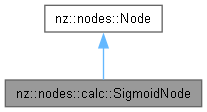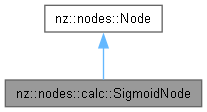 |
NeuZephyr
Simple DL Framework
|
 |
NeuZephyr
Simple DL Framework
|
Represents a Sigmoid activation function node in a computational graph. More...


Public Member Functions | |
| SigmoidNode (Node *input) | |
Constructor to initialize a SigmoidNode for applying the Sigmoid activation function. | |
| void | forward () override |
Forward pass for the SigmoidNode to apply the Sigmoid activation function. | |
| void | backward () override |
Backward pass for the SigmoidNode to compute gradients. | |
 Public Member Functions inherited from nz::nodes::Node Public Member Functions inherited from nz::nodes::Node | |
| virtual void | print (std::ostream &os) const |
| Prints the type, data, and gradient of the node. | |
| void | dataInject (Tensor::value_type *data, bool grad=false) const |
| Injects data into a relevant tensor object, optionally setting its gradient requirement. | |
| template<typename Iterator > | |
| void | dataInject (Iterator begin, Iterator end, const bool grad=false) const |
| Injects data from an iterator range into the output tensor of the InputNode, optionally setting its gradient requirement. | |
| void | dataInject (const std::initializer_list< Tensor::value_type > &data, bool grad=false) const |
| Injects data from a std::initializer_list into the output tensor of the Node, optionally setting its gradient requirement. | |
Represents a Sigmoid activation function node in a computational graph.
The SigmoidNode class applies the Sigmoid activation function to the input tensor. The Sigmoid function is defined as:
It is commonly used in neural networks for binary classification tasks or as a gating mechanism in recurrent networks.
Key features:
This class is part of the nz::nodes namespace and is used to add non-linearity to models or normalize outputs.
|
explicit |
Constructor to initialize a SigmoidNode for applying the Sigmoid activation function.
The constructor initializes a SigmoidNode, which applies the Sigmoid activation function to an input tensor. It establishes a connection to the input node, initializes the output tensor, and sets the type of the node to "Sigmoid".
| input | A pointer to the input node. Its output tensor will have the Sigmoid activation applied. |
inputs vector to establish the connection in the computational graph.output tensor is initialized with the same shape as the input tensor, and its gradient tracking is determined based on the input tensor's requirements.
|
overridevirtual |
Backward pass for the SigmoidNode to compute gradients.
The backward() method computes the gradient of the loss with respect to the input tensor by applying the derivative of the Sigmoid activation function. The gradient is propagated using the formula:
SigmoidBackward) is launched to compute the gradients in parallel on the GPU.output tensor's data and combined with the gradient of the output tensor to compute the input gradient.requiresGrad property is true.Implements nz::nodes::Node.
Definition at line 379 of file Nodes.cu.

|
overridevirtual |
Forward pass for the SigmoidNode to apply the Sigmoid activation function.
The forward() method applies the Sigmoid activation function element-wise to the input tensor. The result is stored in the output tensor. The Sigmoid function is defined as:
It maps input values to the range (0, 1).
Sigmoid) is launched to compute the activation function in parallel on the GPU.output tensor to ensure efficient GPU utilization.output tensor for use in subsequent layers or operations.Implements nz::nodes::Node.
Definition at line 373 of file Nodes.cu.
